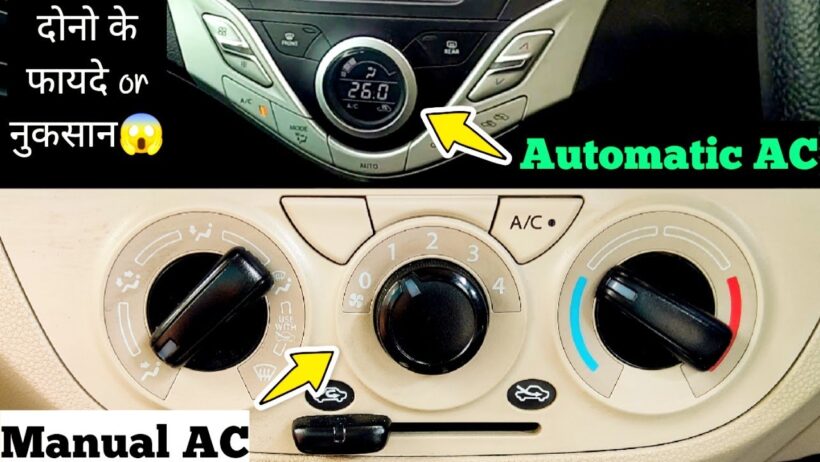In the realm of automotive technology, few features have garnered as much attention and intrigue as climate control systems. Among these, the distinction between manual and automatic climate control systems stands out. Understanding the nuances of these two types of systems not only enhances the driving experience but also reveals a fascinating intersection of engineering, convenience, and user preference.
At first glance, the operational framework of manual and automatic climate control systems appears straightforward. Manual climate control typically requires the driver or passengers to regulate the temperature by adjusting knobs or sliders. This hands-on approach grants individuals a sense of agency, allowing them to determine the precise temperature and airflow within the vehicle. Such systems are typically simpler in design and can be found in older vehicles or more basic models. Yet, they demand an active engagement from the user, who must continuously monitor and revise settings based on changing external conditions.
On the other hand, automatic climate control represents a leap into the realm of automation and sensory feedback. This technology employs various sensors to gauge cabin temperature, external temperature, and humidity levels. The system then regulates the heating, ventilation, and air conditioning (HVAC) automatically to maintain a pre-set temperature. This hands-free model not only adds convenience but also enhances comfort, enabling occupants to focus on the road rather than fiddling with controls.
One might wonder: why such a fascination with the differences between manual and automatic systems? The answer lies beneath the surface, where the integration of technology into everyday life is reshaping expectations. As cars evolve into multifaceted machines equipped with sophisticated technologies, the transition from manual to automatic climate control embodies broader societal shifts toward automation and connectivity. It reflects an era where convenience and efficiency are paramount, paving the way for greater acceptance of advanced driving aids.
Moreover, the impact of these systems extends beyond mere comfort. Climate control technologies, whether manual or automatic, play a crucial role in energy management. Automatic climate control systems, through their intelligent regulation, can optimize energy consumption. For instance, by cycling the air conditioning on and off, these systems can prevent the overuse of energy, which is beneficial in terms of both fuel efficiency and emissions reduction. This becomes increasingly significant in a climate-conscious world where carbon footprints are under scrutiny.
Another aspect to consider is the emotional resonance of driving. For some drivers, the tactile experience of adjusting a manual climate control system offers a deeper connection to the vehicle. The simple act of turning a knob or pushing a button can evoke a sense of nostalgia or control—qualities that many drivers cherish. In contrast, automatic systems may inspire a different emotional response, one rooted in a desire for luxury and ease. This dichotomy highlights the interplay between technology and human emotion, underscoring how vehicle design influences not just practicality but also the driving experience itself.
Furthermore, it’s essential to consider the way different demographics interact with these systems. Younger drivers, who have grown up in an era of technological innovation, often gravitate towards automatic climate control systems for their convenience and seamlessness. In contrast, older generations, who may have developed skills and habits around manual systems, might prefer the tangible engagement that manual controls offer. This generational gap in preferences exemplifies how automotive technology can reflect broader changes in lifestyle and attitudes towards technology.
Additionally, the importance of personalization in modern vehicles cannot be overstated. Automatic climate control systems often come equipped with features that allow users to set specific preferences. For example, dual-zone climate control enables drivers and passengers to select different temperature settings, catering to individual comfort levels. This customization can significantly enhance the driving experience, allowing for harmonious journeys where all occupants feel at ease.
Despite the apparent advantages of automatic systems, they are not without drawbacks. The complexity of automatic climate control can pose challenges for drivers unfamiliar with the technology. A reliance on sensors can sometimes lead to miscalculations in terms of comfort levels, particularly in extreme climates. Moreover, when systems malfunction, they can be more difficult and costly to repair compared to their manual counterparts. Understanding these potential pitfalls is crucial for consumers making informed decisions about their vehicle purchases.
In addition, the environmental implications of each system merit consideration. While automatic systems can offer energy efficiency, the manufacturing process behind advanced technology can also result in increased resource consumption. It’s vital to weigh the convenience of auto systems against their environmental footprint. Cars equipped with more sophisticated technologies often demand a higher energy input during production, which can offset some of the environmental benefits during their operational life.
The choice between manual and automatic climate control is not merely a pragmatic one; it encapsulates a broader conversation about technology, comfort, and environmental responsibility. As individuals navigate the nuances of selecting their ideal vehicle, it’s important to recognize the implications of their choices on the world around them. Being informed about the benefits and drawbacks of each system fosters a more engaged consumer, one who is better equipped to make decisions that align with their values, especially concerning our collective response to climate change.
Ultimately, whether driving an older model with manual climate control or a contemporary vehicle featuring cutting-edge technology, the goal remains the same: to create a comfortable, enjoyable, and, importantly, responsible driving experience. Understanding the deeper implications of these systems can lead to a more thoughtful appreciation of the technologies that underpin modern automobiles. As we move forward into an era marked by rapid advancements, reflecting on these choices will undoubtedly shape the future of transportation in a climate-conscious world.








